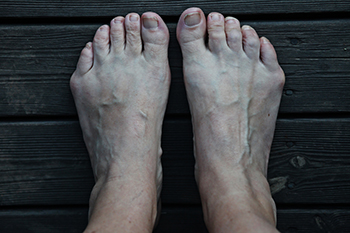
A tailor's bunion, also known as a bunionette, is a condition characterized by the formation of a bony lump on the outer side of the little toe. This condition occurs when the fifth metatarsal bone, which is the bottom bone of the little toe, enlarges or shifts outward. Although less common than big toe bunions, a tailor's bunion can still cause discomfort and pain. Symptoms of a tailor's bunion include a swollen bump on the outer side of the toe, which can become red and painful, especially when it rubs against footwear. Tailor's bunions can affect one or both feet. Factors that contribute to the development of tailor's bunions include wearing ill-fitting shoes, being genetically predisposed to structural foot abnormalities, and having loose foot ligaments. A lower-than-normal fifth metatarsal bone or tight calf muscles can also contribute to the condition. In severe cases, surgery may be recommended. For help with a bunionette, it is suggested that you make an appointment with a podiatrist.
If you are suffering from bunion pain, contact Dr. Steven Sheridan of Ankle & Foot Specialty Clinics. Our doctor can provide the care you need to keep you pain-free and on your feet.
What Is a Bunion?
Bunions are painful bony bumps that usually develop on the inside of the foot at the joint of the big toe. As the deformity increases over time, it may become painful to walk and wear shoes. Women are more likely to exacerbate existing bunions since they often wear tight, narrow shoes that shift their toes together. Bunion pain can be relieved by wearing wider shoes with enough room for the toes.
Causes
- Genetics – some people inherit feet that are more prone to bunion development
- Inflammatory Conditions - rheumatoid arthritis and polio may cause bunion development
Symptoms
- Redness and inflammation
- Pain and tenderness
- Callus or corns on the bump
- Restricted motion in the big toe
In order to diagnose your bunion, your podiatrist may ask about your medical history, symptoms, and general health. Your doctor might also order an x-ray to take a closer look at your feet. Nonsurgical treatment options include orthotics, padding, icing, changes in footwear, and medication. If nonsurgical treatments don’t alleviate your bunion pain, surgery may be necessary.
If you have any questions, please feel free to contact our office located in Sandusky, MI . We offer the newest diagnostic and treatment technologies for all your foot care needs.
